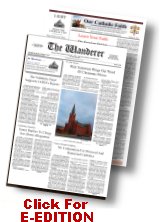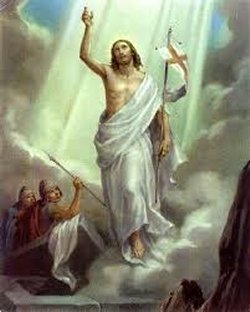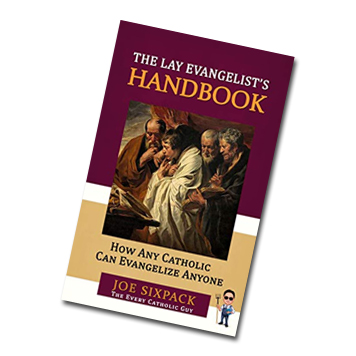For A Great-Nephew… A Short History Of Religious Orders And Religious Life
By PHILIP TROWER
Dear B.: When we were having lunch the other day I told you that the chaplain in the Catholic old people’s home where I am now living is “a friar” and you replied “What is a friar?” You seem to have forgotten about Robin Hood and Friar Tuck. As Friar Tuck, however, isn’t a good example of what a friar should be, we will leave him aside.
The word “friar” is a shortened form of the word “frater” meaning “brother” and is the name for a member of a Catholic community of men leading lives dedicated to the service of God and their fellowmen through prayer and some kind of work which can be practical, missionary, or intellectual. Grouped together as a national or international organization such communities are described as “religious orders.”
Like members of other religious orders, friars will also have bound themselves to practice what are called the evangelical counsels; poverty, chastity and obedience. There are three main kinds or “orders” of friars, Franciscan, Dominican, Carmelites, with nuns to match, just as there are Benedictine nuns as well as Benedictine monks.
The word “nun” is simply a generic name for women leading a similar kind of communal religious life.
So much for what a friar is. It doesn’t tell you much, however. So, since as an Anglican you wrote your university dissertation on the origins of the cult of martyrs in the early Church, I thought you might be interested if I gave you a brief run-through of the history of religious orders in the Catholic Church, or the consecrated life as it is likewise called.
All this dimension of Christian life has its roots in the passage in the Acts of the Apostles where St. Luke, speaking of the very first Christians, says: “Now the company of those who believed were of one heart and soul, and no one said that any of the things he possessed was his own, but they had everything in common.” However, the apostles and their successors seem fairly quickly to have decided that it wouldn’t do for the whole Church. Possessions in common, and subsequently life in common, had to be a special vocation.
Here is how the new Catechism of the Catholic Church puts it. “From the very beginning of the Church there were men and women who set out to follow Christ with greater liberty, and to imitate him more closely by practicing the evangelical counsels. They led lives dedicated to God, each in his own way. Many of them, under the inspiration of the Holy Spirit, became hermits or founded religious families. These the Church, by virtue of her authority, gladly accepted and approved” (CCC, n. 918).
Their lives were to be “devoted to the praise of God and salvation of the world” (CCC, n. 920). The last sentence is particularly significant. There is nothing selfish about the consecrated religious life. It is a call to give up your life and independence for the benefit of other people.
St. Ignatius of Antioch gives one of the reasons why. “Do your best to meet more often to give thanks and glory to God. When you meet frequently the powers of Satan are confounded and in the face of your corporate faith his maleficence crumbles” (St. Ignatius of Antioch, Letter to the Ephesians).
Faithful religious are like lightning conductors. Only at the Last Day shall we know how much the world has owed to their prayers and mortifications.
As a noticeable historical phenomenon all this began in the deserts of Palestine and Egypt in the late 200s AD, which means not long before the persecution of Diocletian followed by the conversion of Constantine. It started with hermits, men living on their own in the desert, who, in addition to praying and doing penance, supported themselves by weaving and selling mats and similar things.
Most of the first hermits did not live in complete isolation. If a man had a reputation for holiness, younger men would group themselves or their cells within reach of his cell so that they could receive his guidance or spiritual direction. He was their spiritual father. We know the names of some of these spiritual guides or “desert fathers” and what their teaching was like because we have a book of The Sayings of the Desert Fathers dating from the middle to late 300s.
The earliest Christian hermits to achieve notoriety were St. Paul, nicknamed “the First Hermit,” and St. Anthony of Egypt (251-356). We know little about the former. But the latter was to have a great influence down the centuries. He left letters as well as sayings, and his “Life” was written by St. Athanasius, the famous bishop of Alexandria and champion of orthodox Christianity at the time of the Arian heresy (c. 318-381).
It is here that we learn, among other things, about St. Anthony’s struggles with the Devil and the temptations he underwent, a subject much loved by Western European painters like Hieronymus Bosch and Grunewald.
The pioneer period of hermits alone, however, did not last long. The year AD 287 saw the birth of St Pachomius, the founder of what is called “cenobitic monasticism”; that is, men or women who wanted to dedicate their lives to God living together in community. This involved providing them with a rule of life the way any organized body of human beings has to have rules and regulations if they are to live in together in harmony. He founded 11 houses for men and three for women. Eventually these multiplied all over the Middle East.
Three of these early “monasteries,” as they came to be called, still survive in the Egyptian desert west of Cairo and are or were easily reached by anyone visiting that city. From a distance they look like small fortified villages. The fortifications were necessary to protect the monks from possible raids by desert tribes. After the rise of Islam that would mean Bedouin Arabs. Today, however, the Bedouins are regular recipients of the monks’ charity. They ring a bell and a basket of food is lowered down to them from an opening in the walls.
What St. Pachomius achieved in Egypt — that is, initiate a form of “cenobitic monasticism” or communal religious living under the leadership of an elected spiritual father or abbot according to an accepted set of rules — St. Basil (329-379) did a bit later in Asia Minor and Eastern Europe, and St. Benedict (c. 480-547), about a century after that in Western Europe. St. Basil, a “doctor of the Church,” is one of her greatest theologians, while St. Benedict we associate, among other things, of course, with the great monastery he founded at Monte Cassino. The majority of Greek Orthodox monks and nuns follow St. Basil’s rule.
More or less simultaneously a form of cenobitic monasticism based on the lives of the Desert Fathers began developing in the Celtic world after the conversion of the Irish by St. Patrick in the mid-400s and the Scotch mostly by Irish missionaries about a century later.
We can say that, together with the Church as a whole, “cenobitic monasticism,” whether Basilian, Benedictine, or Celtic, was the main force responsible for turning the barbarian tribes who destroyed the Roman Empire into the beginnings of civilized human beings. In Western Europe, between 550 and 1150, it underwent a variety of modifications. Sometimes these were reforms, sometimes developments. Cluniacs were examples of the former, Cistercians, Carthusians, and Canons Regular of the latter.
But the fundamentals remained the same. Stability or attachment of each monk or nun to a particular monastery or religious house was one. Pride of place given to prayer and singing the praises of God in choir — the Opus Dei or Work of God — was another. Work in the ordinary sense could be of a variety of kinds, but not one that involved living away from your monastery for any length of time. We owe to the monks, of course, the marvelous illustrated manuscripts which have come down to us. They were also great benefactors of the destitute poor.
There were exceptions to the stability, of course. In the seventh and eighth centuries there were missionary Benedictines like St. Boniface who evangelized large areas of Germany, while Celtic missionary monks penetrated as far as Italy. But stability remained the general rule. The monastery you first entered remained your home for life.
The coming of the friars at the end of the 1100s and beginning of the 1200s marks the first major change in nature of communal religious living in the Catholic Church. The three main forms, as I said, were the Dominicans (black friars), Franciscans (gray friars), and Carmelites (white friars), so called after the color of their cloaks. But the most important thing about them is that they were the first religious orders in the modern sense.
By this I mean that the members, instead of each being attached by a vow of stability to an individual house, were more like “an army of priests organized under a Master-General in provinces, and ready to go wherever they were needed, without any obligations of stability to this house or that, owing their stability, not to any particular house, but to the order and the will of their superior. This was a surprising and most fruitful innovation, and every order has since adopted it” (A Short History of the Catholic Church, Philip Hughes; London, 1978, pp. 105-106).
Their work could be missionary, educational, or charitable, but whatever it was their houses were mostly in towns rather than out in the country. That is why we have an area of London and a bridge over the Thames called Blackfriars.
The Dominicans or Friars Preachers, whose special charism was to be preaching and teaching, were also “the first major order to substitute intellectual work for manual labor” (Modern Catholic Dictionary, John Hardon SJ. See entry on Dominicans), one result being that in St. Thomas Aquinas they produced the Church’s greatest philosopher-theologian.
The Franciscans, whose fame as a religious order has been all but overshadowed by the unsurpassed holiness and lovableness of their founder, excelled in missionary and social work, but likewise produced their crop of famous theologians. I use the word missionary here not just in the sense of carrying the faith to non-Christians but reviving and strengthening the faith of already believing faithful. As for the Carmelites, their origin was more complex. Originating as a group of hermits driven out of Palestine by the Saracens, they were organized as a religious order of the new kind by the Englishman St. Simon Stock at Aylesford in Kent southeast of London around the middle of the 1200s.
Many religious orders, both of the traditional monastic kind and the new more peripatetic kind, were founded during the high and later Middle Ages and we can roughly categorize them as verging either toward the active or contemplative life, the latter being the kind in which prayer and penance predominate. Not surprisingly, most women’s orders were of the latter kind down to the Renaissance and Reformation. Both St. Francis’ nuns (Poor Clares) and St. Dominic’s were contemplatives. Nuns had been involved in teaching as they had in works of charity from the earliest times, but the first major women’s teaching order was founded by St. Angela Merici in 1525.
Meanwhile no religious order comparable in size to the Dominicans, Franciscans, or Benedictines made its appearance until the founding of the Jesuits by St. Ignatius Loyola in the mid-1500s. By this time Columbus and the Portuguese discoverers had opened the greater part of the world to contact with Europe. For several centuries, the Jesuits were to be the Church’s greatest missionary and teaching order.
Contemporary with the founding of the Jesuits, but as important in its own rather different way, was the reform of the Carmelites carried out by St. John of the Cross and St. Teresa of Avila. It gave a boost to the Church’s prayer life that has lasted down to today, receiving a further impetus in the late 19th century from the teaching of St. Therese of the Child Jesus, also a Carmelite, with her way of spiritual childhood.
The 16th, 17th, 18th, and 19th centuries also saw the founding of many new women’s orders dedicated to teaching and looking after the sick and poor. Then with the advent of the Industrial Revolution what had been a steady flow became a torrent, so great was the need generated by conditions in the new industrial cities.
Indeed, when I came into the Church in 1953 there was a clerical joke which went: “What are the two things God doesn’t know?” Answer: “What a Jesuit is thinking and how many women’s religious orders there are.” But it was a tremendous testimony to the truth of their beliefs.
Ecclesial Movements
To complete this survey of religious orders and communities in the Catholic Church, I will end with a new but not unrelated phenomenon. I mean the associations of lay people, or “ecclesial movements” as they are called, which began to make their appearance early in the 20th century, when they were known collectively as Catholic Action, and which have multiplied greatly since the Second Vatican Council (1962-1965).
I am thinking of movements like, Communion and Liberation, the Emmanuel Community, Opus Dei or Sant’Egidio, to name only a few. They may differ in structure. But the main objective is the same: to make the members more fervent more missionary Christians and to bring the Good News of the Gospels to modern society as it were from within.
They are not unlike the “tertiaries” or groups of lay people affiliated to the three orders of friars from the time of the Middle Ages. That is to say, “groups of lay people living in the world who are striving after Christian perfection insofar as their station in life allows.” Like the tertiaries, they do not live together in common or profess the evangelical counsels. They differ from the tertiaries in that each is independent and has its own special apostolate. They are not affiliated to any religious order.
Whether married or single, the majority of members continue to lead their ordinary everyday lives as lawyers, businessmen, farmers, industrial workers, or whatever other profession they may have chosen before they joined. In this way they are in a better position to bring the faith to men and women with little or no knowledge of what Christianity is about and little interest in remedying their ignorance.
But even if living independently, they still have a strong sense of being part of a religious family. They meet at regular intervals for prayer, religious instruction, and discussion under the guidance of one of the priests attached to the movement more or less in the role of chaplains.
In a sense the new lay movements are an attempt to recreate a Christian laity similar to that of the first three centuries of the Church’s life before there were any monasteries or religious orders. It was then taken for granted that being a Christian necessarily meant trying to model yourself on our Lord as closely as possible as well as being apostolic and missionary. The latter wasn’t something you left to the clergy or members of a religious order.
This doesn’t mean the new movements should be seen as rivals to the religious orders but as filling a gap. Apostolic laymen and laywomen working largely on their own can reach individuals and areas of modern society inaccessible members of religious orders. But, to be effective, their own spiritual level has to be raised. Emphasis is put on the fact that all Christians have “a vocation” — that is a call to follow Christ as closely as possible and proclaim His Good News — not just priests and members of religious orders. Marriage, or being a lawyer or a businessman, can be a vocation.
Another new phenomenon is called “secular institutes.” These are associations of lay people who, while not living together in common and while pursuing their careers in the world like members of the other lay movements, nevertheless profess the three evangelical counsels.
The history of the Church’s monastic communities and religious orders and now of the new movements, can in many ways be seen as the history of the way the Holy Spirit comes to the rescue of the Church in the succession of emergencies or changing circumstances which lie at the heart of all human history.
Or as Pope St. John Paul II put it: “History witnesses to the outstanding service rendered by religious families in the propagation of the faith and in the formation of new Churches from the ancient monastic institutions to the medieval orders, all the way to the more recent congregations” (Redemptoris Missio, cited in CCC, n. 927).











